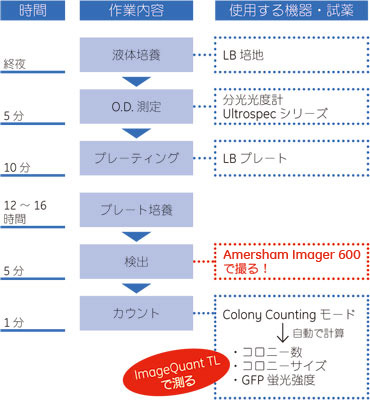Licensing Biomedical Informatics and Research Administration are working together to provide ImageQuant TL software from GE Healthcare Life Sciences for research image analysis. This software was purchased for use with the GE Life Sciences Typhoon 9500FLA digital imager located in R3.302, but can also be used to analyze images from other sources.
- ImageQuant TL offers four separate functional areas within one product: - 1-D electrophoresis gels. Dot blots, microplates, and basic arrays. Colony counting and measurement of 2-D spots and other image features. Toolbox to analyze gels with user-defined objects.
- Article Snippet: The densitometric analysis of SELENBP1 and TPD52L2 when analysed via Image Quant TL (IQTL) software (GE Healthcare) and GraphPad Prism version 7 yielded p-values less than 0.05. Techniques: Microarray, Quantitation Assay, Two Tailed Test.
- Article Title: Initial Report on Differential Expression of Sprouty Proteins 1 and 2 in Human Epithelial Ovarian Cancer Cell Lines Article Snippet: Similar process was carried out for GAPDH protein with a 1: 20000 dilution of anti-GAPDH mouse monoclonal antibody (Sigma-Aldrich, Missouri, USA).Using the ImageQuant LAS 4000 Biomolecular imager and ImageQuant software (GE Healthcare, UK), the.
O valor do frete será somado ao valor dos itens e não estará descrito na nota fiscal.
Imagequant Las 500 - Cytiva Life Sciences - 29005063
Marca: Cytiva
EQUIPAMENTO FOTODOCUMENTADOR PARA CAPTURA DE IMAGENS DE WESTERN BLOTTINGQUIMIOLUMINESCENTE, COLORIMETRICO E UV FLUORESCENTE
Imagequant Tl Iqtl Software Ge Healthcare Software
mais informações
Marca: Cytiva
EQUIPAMENTO FOTODOCUMENTADOR PARA CAPTURA DE IMAGENS DE WESTERN BLOTTINGQUIMIOLUMINESCENTE, COLORIMETRICO E UV FLUORESCENTE
mais informações
As combinações acima não possuem estoque.
Descrição do Produto
ImageQuant LAS 500 is a cooled CCD camera for chemiluminescent Western blot imaging, blue/UV based DNA & protein stains, and white-light imaging of colorimetric stains and markers.
- Sensitivity: detect picogram levels of sample with chemiluminescence.
- Compact integrated design: built-in touchscreen lets you work independently of a dedicated PC, has a small footprint that fits neatly on any lab bench.
- Automatic overlay function: simultaneously image and overlay chemiluminescent samples and colored molecular weight markers, making molecular weight determination easy.
- Flexible image storage: store images on a USB memory stick, on the system, or in a network connection folder.
- Simplicity: auto, semi-auto, and increment exposure modes with a user-friendly touchscreen operation helps you take the best possible image.
- Speed: ready to operate in less than five minutes with the rapid cooling CCD camera.
- Ease of installation: just unpack, power up and start.
Designed for chemiluminescence detection and gel documentation
This CCD imager is a practical and affordable solution to individual researchers or laboratories that are either looking for their own imager or need extra imaging capacity. The 30 × 28 cm footprint has the same area as a typical laptop computer, which allows the imager to fit neatly on almost any lab bench without the need to connect ancillary equipment.
Ready for use in less than five minutes
ImageQuant LAS 500 imager consists of a touchscreen, sample chamber, USB port, camera and light sources. The 8.3-megapixel CCD camera is ready for use in less than five minutes. Reliable Peltier cooling combined with binning significantly reduces noise levels and improves both the sensitivity and linearity of the system.
Flexible imaging modes for Optimal chemiluminescence detection
Signal intensity can be detected either automatically or semi-automatically by specifying an area of interest. In addition, single (manual) or multiple (incremental) exposures can be set by the operator. The camera is designed for optimal chemiluminescence detection with regard to sensitivity and dynamic range.
Three LED light sources
The system features three LED light sources: a combined blue epi-/UV epi-light and a white epi-light. The combined blue epi-/UV epi-light allows imaging of fluorescence signals above 550 nm. This feature makes the camera well suited for DNA stain imaging with SYBR™ Green, ethidium bromide, or Deep Purple Total Protein Stain.
A fast and easy way to verify the molecular weight of detected protein bands
The white epi-light source (470 to 635 nm) enables documentation of colorimetric markers and stains, such as Coomassie Blue or Silver. Moreover, the white light mode can be combined with the chemiluminescence mode to automatically generate an overlay image of the colored marker and chemiluminescent sample images. This provides a fast and easy way to verify the molecular weight of detected bands, and identification of band of interest if multiple bands are generated.
Software
In addition to the on-board software, images acquired using ImageQuant LAS 500 can be analyzed using ImageQuant TL (IQTL). IQTL is an automated and easy-to-use general-purpose gel, blot, and array image analysis software. IQTL requires installation on an external computer and cannot be installed on ImageQuant LAS 500.
Western blot detection
Western blotting, also known as immunoblotting, or protein blotting, is a well-established and widely used technique for the detection and analysis of proteins. A variety of detection systems, based on chemiluminescence, chemifluorescence, fluorescence, chromogenic, or radioisotopic detection are available. Chemiluminescence is reliable and well known for having the greatest sensitivity of any available detection method.
Further, there has been a decline in usage of radioisotopic and chromogenic reagents due to safety issues with handling radioactive isotopes and poor sensitivity with chromogenic reagents, which has meant, enzyme-based chemiluminescent and direct fluorescence have been extensively developed and are now the preferred method for detection due to their improved sensitivity and wider dynamic range.
What is chemiluminescence western blot detection?
Imagequant Tl Iqtl Software Ge Healthcare Products

Chemiluminescence Western Blot detection is based on antibodies conjugated to horseradish peroxidase (HRP) that catalyze the oxidation of luminol in presence of peroxide, resulting in light emission. HRP has several advantages over other enzymes such as alkaline phosphatase (AP). HRP can be easily conjugated to antibodies or streptavidin (which binds with extraordinarily high affinity to biotin, a commonly used tag, and can be used with different chemiluminescent reagents. Considerable efforts have been made to develop HRP-based detection reagents to obtain higher detection sensitivity, stronger light intensity and long-lasting signals.